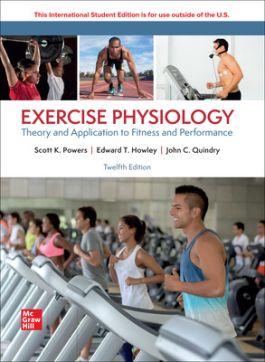Exercise Physiology: Theory and Application for Fitness and Performance ISE
SECTION 1 Physiology of Exercise
Chapter 0 Introduction to Physiology of Exercise
Chapter 1 Common Measurements in Exercise Physiology
Chapter 2 Control of the Internal Environment
Chapter 3 Bioenergetics
Chapter 4 Exercise Metabolism
Chapter 5 Cell Signaling and the Hormonal Responses to Exercise
Chapter 6 Exercise and the Immune System
Chapter 7 The Nervous System: Structure and Control of Movement
Chapter 8 Skeletal Muscle: Structure and Function
Chapter 9 Circulatory Responses to Exercise
Chapter 10 Respiration during Exercise
Chapter 11 Acid-Base Balance during Exercise
Chapter 12 Temperature Regulation
Chapter 13 The Physiology of Training: Effects of Aerobic and Anaerobic Training
Chapter 14 The Physiology of Resistance Training
SECTION 2 Physiology of Health and Fitness
Chapter 15 Exercise Is Medicine—Part 1: Prevention of Chronic Diseases
Chapter 16 Exercise is Medicine—Part 2: Therapy for Chronic Diseases and Prevention of Age-related Physiological Dysfunction
Chapter 17 Exercise is Medicine—Part3: Exercise Prescriptions for Health and Fitness
Chapter 18 Nutrition, Body Composition, and Weight Management
SECTION 3 Physiology of Performance
Chapter 19 Factors Affecting Performance
Chapter 20 Training for Performance
Chapter 21 Training for the Female Athlete, Children, Special Populations, and the Masters Athlete
Chapter 22 Nutrition, Body Composition, and Performance
Chapter 23 Exercise and the Environment
Chapter 24 Ergogenic Aids
Appendices
Appendix A: Calculation of Oxygen Uptake and Carbon Dioxide Production
Appendix B: Dietary Reference Intakes: Estimated Energy Requirements
Appendix C: Dietary Reference Intakes: Vitamins
Appendix D: Dietary Reference Intakes: Minerals and Elements
Appendix E: Percent Fat Estimate for Men: Sum of Triceps, Chest, and Subscapula Skinfolds
Appendix F: Percent Fat Estimate for Women: Sum of Triceps, Abdomen, and Suprailium Skinfolds
Appendix G: MET Equivalents for Exercise, Activities of Daily Loving, and Household Chores
Glossary
Index
McGraw Hill Connect is an award-winning digital teaching and learning solution that empowers students to achieve better outcomes and enables instructors to improve course management efficiency.
High-Quality Course Material
Our trusted solutions are designed to help students actively engage in course content and develop critical higher-level thinking skills while offering you the flexibility to tailor your course to the ways you teach and the ways your students learn.
Assignments & Automatic Grading
Connect features a question bank that you can select from to create homework, practice tests and quizzes. Dramatically reduce the amount of time you spend reviewing homework and grading quizzes, freeing up your valuable time to spend on teaching.
Analytics & Reporting
Monitor progress and improve focus with Connect’s visual and actionable dashboards. Reports are available to empower both instructors and students with real-time performance analytics.
Seamless Integration
Link your Learning Management with Connect for single sign-on and gradebook synchronization, with all-in-one ease for you and your students.


